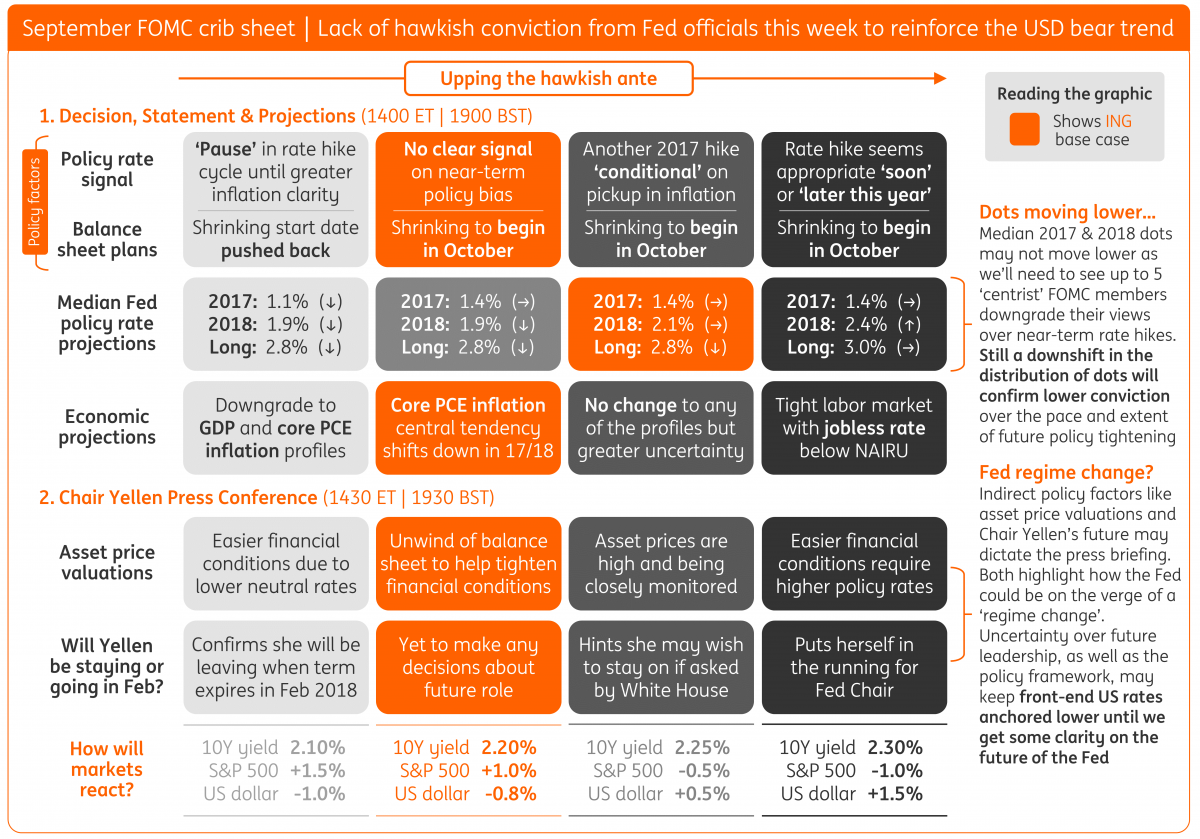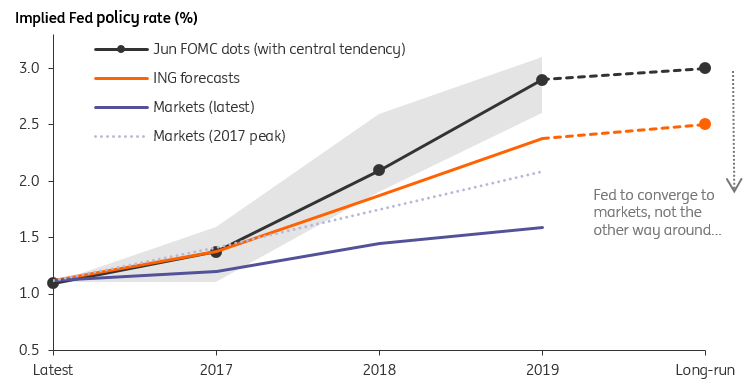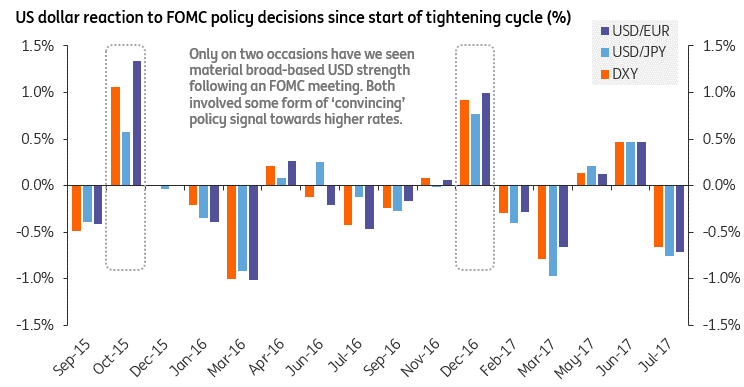Five reasons to expect a weaker US dollar
Good times are hard to come by and that's why we expect the USD's cyclical decline to continue after Wednesday's September FOMC meeting

Fed’s dot plot likely to go through a downgrade
This week's FOMC event may prove to be slightly more difficult for Chair Yellen to navigate as the division with the FOMC over the appropriate near-term policy approach grows.It will be interesting to see how she manages the two emerging camps – i.e. those members looking for a continuation of the current normalisation cycle and those looking for an extended (or even permanent) pause in hikes until there is more confidence in the US inflation outlook.
The balance of risks suggests there is more evidence for the dovish camp within the FOMC. The short-run disruptive effects of Hurricane Harvey (and potentially Irma), North Korea-related geopolitical tensions and lacklustre US inflation dynamics mean that we are likely to see the Fed's dot plot reflect a lower conviction over the pace and extent of future policy tightening.
Here are the key things to look out for when it comes to the Fed's dot plot:
-
While the median 2017 dot is still set to tentatively pencil in a December rate hike, we expect to see more members calling for a pause for the remainder of the year. Anything more than five would suggest the likelihood of additional tightening this year hangs in the balance – with markets right to price in 50:50 odds.
-
More telling of a dovish shift would be if the 2018 dot also moves lower. Here we require five or more members to downgrade their views over future policy hikes – a scenario that cannot be ruled out given the softer US inflation dynamics.
-
It's certainly more likely we'll see the 2019 and longer-run dots moving lower – with Fed officials acknowledging that a 2% handle on the terminal Fed funds rate is more realistic in the current economic environment.
-
We'll also see the introduction of the 2020 dot this month, and we expect this to be in line with the longer-run dot, thereby putting an explicit end-date on the current Fed's hiking cycle.

The storms might wreck Fed’s balance sheet plans
While we do not expect US yields or the USD to move much on what would be a well-telegraphed balance sheet announcement this week, there is a non-trivial risk of the Fed delaying this process. One of the pre-conditions Chair Yellen had stipulated back in March was the need for solid underlying momentum in the US economy, and recent weather-related disruptions may give officials a reason to hold fire.
This would indicate the Fed's more pessimistic view of the US economy, and we expect this tail risk scenario to be an outright negative for the US dollar - more so through the signalling channel, rather than any substantial move lower in US yields.
Rate increases won’t necessarily tighten financial conditions
The July FOMC minutes also pointed to two members expressing contrasting views on another major issue: the interpretation of easier financial conditions and what the appropriate policy response should be. Though one member noted that easier financial conditions might warrant tighter monetary policy (the conventional wisdom), another floated the more avant-garde view that elevated risky asset prices were a response to markets adjusting to structurally lower neutral interest rates - a factor which the Fed cannot control.
This implies that in the absence of inflation, there may be little need for additional Fed rate hikes to tighten financial conditions. We tend to agree, particularly since broader US financial conditions are now clearly becoming less responsive to adjustments in the short-term policy rate. This may well be the same conclusion that Yellen articulates in the press briefing this week, which on its own shouldn't prompt any major re-pricing of Fed policy expectations.
Yellen’s future still hangs in the balance
Chair Yellen’s future is also likely to come up in the press briefing, especially after Vice-Chair Fischer's earlier-than-scheduled resignation announcement. We think uncertainty over the Fed's future leadership, as well as the broader policy framework, maybe keeping front-end US rates flat - with investors sceptical about making wholesale changes to Fed policy assumptions, until there is greater clarity.
The most market-friendly outcome at this stage is if Chair Yellen stays on beyond her term scheduled to expire in February 2018 - even if it is a temporary arrangement.
USD typically moves lower post-FOMC meetings

Hawkish Fed cries set to fall on deaf ears (again!)
Typically, it is difficult for the dollar to rally on Fed meetings and this time may not be any different. Hawkish Fed cries could fall on deaf ears again given the lack of convincing economic evidence. Fading the USD corrective rally may be a wise tactic ahead of the Fed meeting. We fear markets could still shift to the idea that any 'pause' in the Fed’s tightening cycle will be somewhat lengthy (if not permanent) and the risks are that the recent front-end flattening of the US yield curve has further to run.
In the absence of any convincing hawkish signal -such as a reference to another rate hike being 'appropriate soon' - we think the USD is likely to follow the historical pattern of moving lower in the aftermath of the FOMC meeting.
Download
Download article"THINK Outside" is a collection of specially commissioned content from third-party sources, such as economic think-tanks and academic institutions, that ING deems reliable and from non-research departments within ING. ING Bank N.V. ("ING") uses these sources to expand the range of opinions you can find on the THINK website. Some of these sources are not the property of or managed by ING, and therefore ING cannot always guarantee the correctness, completeness, actuality and quality of such sources, nor the availability at any given time of the data and information provided, and ING cannot accept any liability in this respect, insofar as this is permissible pursuant to the applicable laws and regulations.
This publication does not necessarily reflect the ING house view. This publication has been prepared solely for information purposes without regard to any particular user's investment objectives, financial situation, or means. The information in the publication is not an investment recommendation and it is not investment, legal or tax advice or an offer or solicitation to purchase or sell any financial instrument. Reasonable care has been taken to ensure that this publication is not untrue or misleading when published, but ING does not represent that it is accurate or complete. ING does not accept any liability for any direct, indirect or consequential loss arising from any use of this publication. Unless otherwise stated, any views, forecasts, or estimates are solely those of the author(s), as of the date of the publication and are subject to change without notice.
The distribution of this publication may be restricted by law or regulation in different jurisdictions and persons into whose possession this publication comes should inform themselves about, and observe, such restrictions.
Copyright and database rights protection exists in this report and it may not be reproduced, distributed or published by any person for any purpose without the prior express consent of ING. All rights are reserved.
ING Bank N.V. is authorised by the Dutch Central Bank and supervised by the European Central Bank (ECB), the Dutch Central Bank (DNB) and the Dutch Authority for the Financial Markets (AFM). ING Bank N.V. is incorporated in the Netherlands (Trade Register no. 33031431 Amsterdam).
